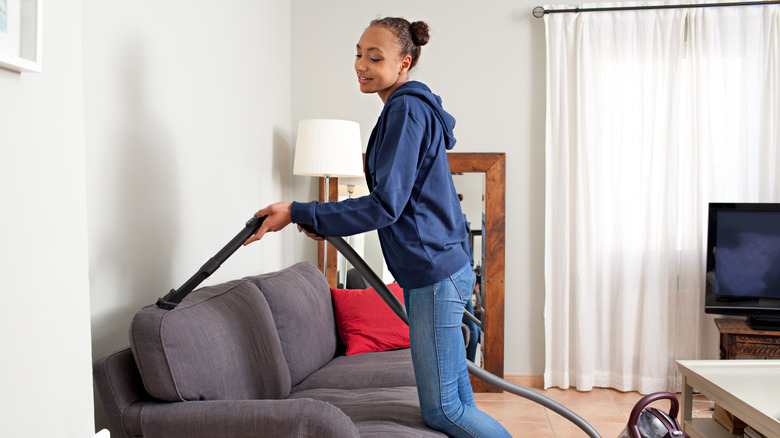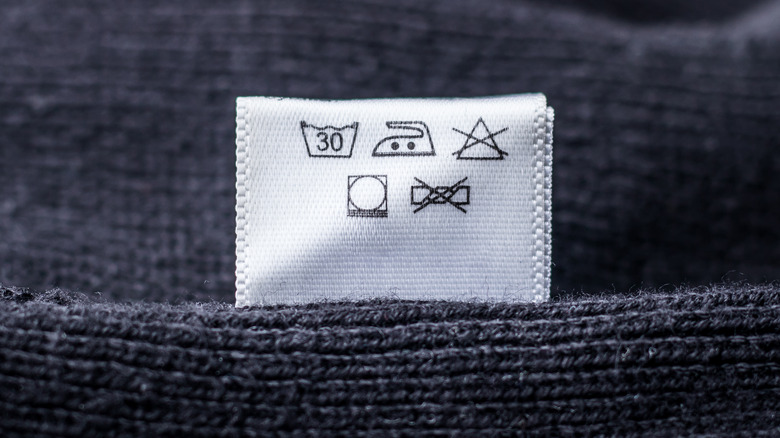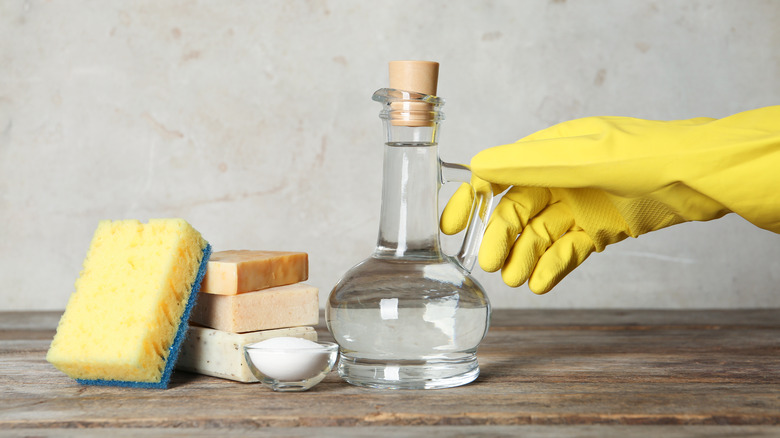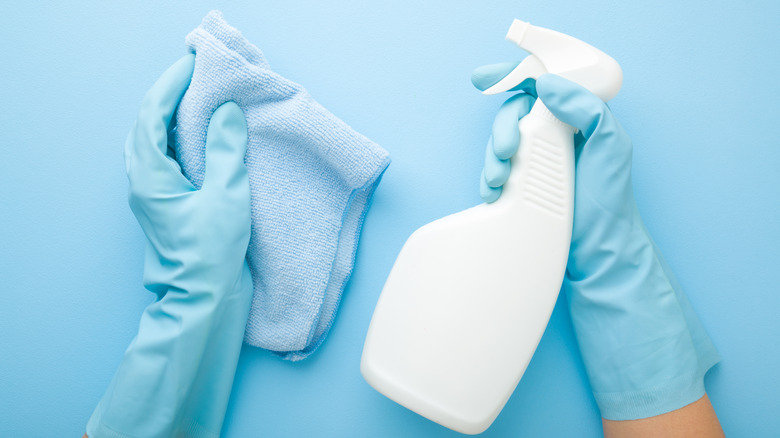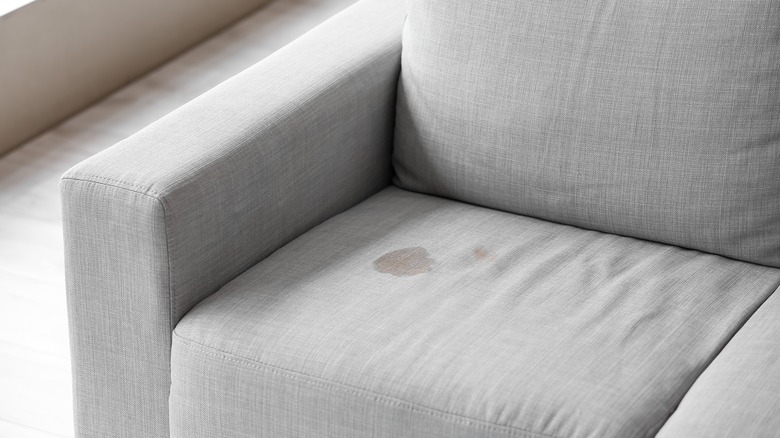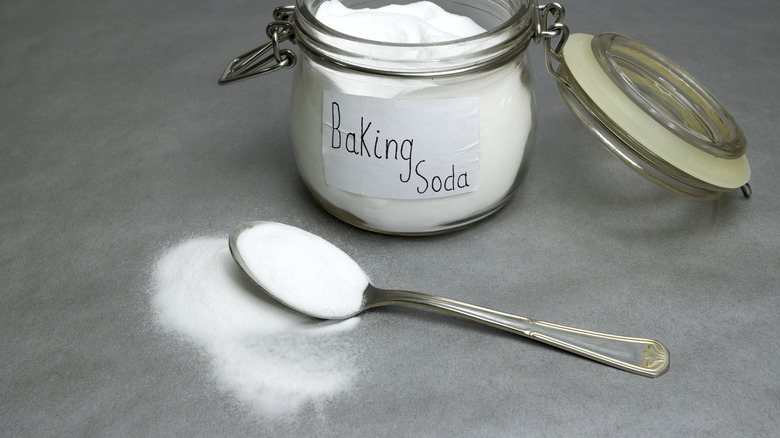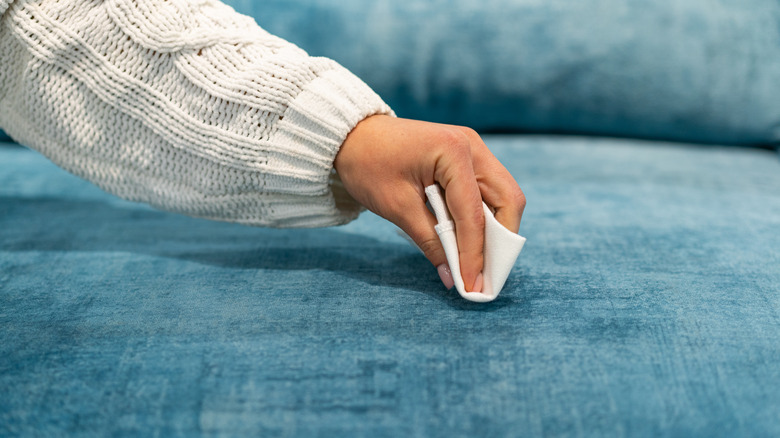8 Best Ways To Clean Polyester Furniture
We may receive a commission on purchases made from links.
Polyester fabrics are becoming an increasingly popular material when it comes to furniture, both inside and outside of the home. Najarian Furniture states that because polyester is a type of synthetic fabric, it can sometimes be frowned upon as a material for furniture, but it comes with a wide range of benefits that are perfect for a busy household setting.
Furniture made with natural fabric is undoubtedly very pleasant to own, but it can cost a fortune depending on the specific type of upholstery and the dimensions of the furniture. Polyester, on the other hand, is a very affordable material and can be made to look just as nice as other types of furniture materials. In fact, while most natural fibers only come in neutral or natural colors, polyester can be any color you desire. Along with its style and affordability, polyester is also durable and easily cleaned.
If you're wondering if polyester is the right material for you and your home, first you should consider how to properly maintain your polyester furniture and get the most out of your minimal investment.
1. Routine cleaning
One of the best ways to keep your polyester furniture looking and functioning great is by cleaning it on a regular basis. Home Made Simple claims that quick furniture cleaning doesn't require more than a few minutes each day with a dry brush and a vacuum cleaner.
Start by using the brush to loosen up any dirt, lint, pet hair, and any other type of debris that may be stuck to the upholstery. While brushing, always start with the top cushions before moving to the arms, sides, seat, and back of the couch. When you have finished brushing, take your vacuum cleaner, and use the detachable hose and brush attachment to suck up all the dirt and debris you just brushed loose with your brush. During this process, it is highly recommended to also remove all the cushions from the furniture, allowing you to vacuum behind and underneath them.
2. Read the manufacturing label
Before jumping right into a deep cleaning technique for your polyester furniture, it is important to first read the manufacturing label. House & Beyond explains that manufacturing labels help you pick the right cleaning products and methods for your particular furniture item. Using the codes listed on the manufacturing label, you can ensure you are utilizing the right solutions and methods to safely and properly clean your furniture. Some of the code you should look for include the following:
- W – means that your polyester furniture can be safely cleaned with water and other water-based products.
- S – symbolized that the item should either be dry cleaned or spot cleaned with a solvent, which is not a water-based solution.
- X – recommends that the furniture only be cleaned with a dry method, for example, a vacuum or dry brush.
- W/S – shows that the product is versatile and can be cleaned with either a water-based solution or a solvent cleaner.
3. Water and vinegar
If the manufacturing label confirms that you can safely use a water-based solution to clean your polyester furniture piece, Spadone Home recommends using a homemade solution with vinegar, laundry detergent, and warm water.
Start by mixing together 1 tablespoon of vinegar, 1 tablespoon of laundry detergent, and some warm water in a clean spray bottle. When the solution is ready, test it in an unnoticeable area of your furniture to ensure it will not cause any harm to the color or texture. When you are confident that no damage will occur, spray it onto the furniture and rub it in to clean. For stained areas, you may need to rub harder to eliminate the stains. When finished, the solution does not need to be rinsed off the furniture. Instead, take a dry brush and rub the polyester to revive its original texture. Be sure to let the surface dry before you use it again.
4. Black diamond
Using a specific polyester cleaner is another great way to safely clean your polyester furniture. Depending on what's stated on your furniture's manufacturing label, House & Beyond highly recommends using Black Diamond carpet and upholstery cleaner. This is a great product when cleaning spots, stains, and spills on a variety of different upholstery and fabrics. Along with its strong cleaning power, Black Diamond is also perfectly safe to use in households with children and pets.
When using this product, always start by first vacuuming the couch to remove loose dirt and debris. Spray directly onto the slightly dampened surface, then, with a clean cloth, gently rub or blot the cleaner into the furniture. To help revive the texture of your furniture piece after cleaning, brush the fabric in a circular motion with a dry bristle brush. Finally, let your furniture dry completely before returning it to its normal use.
5. Removing common stains
To remove stains from your polyester furniture, it's important to know what kind of stains you are dealing with as different stains require different methods to get rid of them. For example, common food stains can easily be removed with the vinegar and water solution. Honest Home Talks, however, also mentions that shampoo and baking soda can also be used to good effect.
For things like blood stains, House Rituals recommends using hydrogen peroxide on a dampened towel to wipe the stain. Grease stains need to be treated quickly with baking soda, therefore, as soon as you find a grease stain on your polyester furniture, layer the baking soda on top and let it sit for approximately one hour. Afterward, brush the baking soda away and clean it as you would any other dirt spot, which can be either with vinegar and water or hydrogen peroxide. Finally, if you happen to have an ink spill on your polyester furniture, hair spray is known for being the perfect removal solution.
6. Removing urine
Although unpleasant, if you have pets or children, removing urine from your polyester furniture may be a harsh reality for you. House&Beyond shares a simple way to successfully remove urine from your polyester furniture, instead of allowing it to spoil. First, start by removing as much urine as you can with a simple paper towel before coating the area with baking soda and white vinegar. Let the mixture sit for a while before taking a clean rag or fresh paper towel and blotting the solution and urine away.
If the urine has been allowed to sit on your furniture for a while, House & Beyond recommends using a stronger solution, consisting of hydrogen peroxide and a mild cleaner or dish soap. This solution should then be spread over the stain until it is clean. If after cleaning your furniture it still smells, baking soda is an effective way to freshen up your polyester.
7. Baking soda
Although baking soda alone will not physically clean your polyester furniture, it is known for deodorizing and freshening it up. Cozey Sofas mentions odors tend to vanish almost immediately after using baking soda on polyester furniture pieces.
To use baking soda, first ensure that both the baking soda and the surface of your furniture are dry. Sprinkle a thin layer onto the surface of your furniture piece and let it sit for about 20 minutes — It is important to remember to only use a thin layer of baking soda to avoid the substance being caked onto your furniture. If you think your furniture piece smells really bad and needs more than just a thin layer, you can do the process multiple times, but do avoid an excess amount of baking soda. Finally, after you have allowed the baking soda to sit for at least 20 minutes, simply vacuum the baking soda away and enjoy your fresh-smelling furniture.
8. Mistakes to avoid
When it comes to cleaning polyester furniture, there are some common issues that can be easily avoided. First and foremost, Honest Home Talks states that removing a stubborn stain may require a bit of scrubbing. The mistake that people make when it comes to scrubbing, however, is scrubbing too hard. If you put too much pressure on your furniture piece when you scrub, you may stretch the fabric or damage the padding underneath.
When using a new cleaner to either remove a stain or simply clean the surface of your furniture, another mistake many people make is not testing the cleaner first. You never know how the cleaner will react to your specific polyester surface; therefore, it must always be tested in an inconspicuous spot before diving right into the main cleaning process. On top of this, another common mistake is not checking the manufacturing label before cleaning your furniture. The manufacturing label should tell you everything you need to know to keep your polyester furniture safe during your cleaning process.

